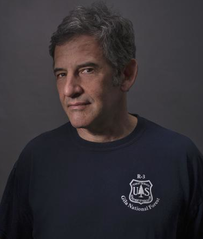
“Nature Noir” won favor with reviewers in the New York Times and other influential national publications, vaulting Smith onto the national stage for environmental issues.
Eleven years later, the south Nevada County resident travels farther afield, highlighting Alabama man Harry Walker’s hitchhiking journey in 1972 to Yellowstone National Park. Walker’s death after being attacked by a grizzly bear provides the focus and an ensuing civil trial that calls into question the National Park Service’s handling of the wildlands and wildlife under its care takes the story into the realm of courtroom drama.
Published under the Penguin-Random House Crown imprint, “Engineering Eden” is now out and getting a round of positive reviews similar in praise to “Nature Noir.”
“Intensely reported, rousingly readable and ambitiously envisioned,” is the Wall Street Journal opinion. Entertainment Weekly describes “Engineering Eden” as simply “stunning.” And the Seattle Times review is also onboard the Smith bandwagon with an enthusiastic ‘thumb up.’
“Smith’s book will draw you in with his passion, thoughtfulness and first-rate story telling,” the Times states.
Auburn SRA influences
While the focus of “Engineering Eden” is on places outside the realm of the Auburn State Recreation Area, you can’t take the Auburn State Recreation Area influences out of “Engineering Eden,” Smith said Monday.
Smith worked in the recreation area in the 1980s and 1990s, experiencing a tragedy similar to Walker’s death in 1972 when Placerville distance runner Barbara Schoener was killed by a mountain lion near Auburn Lake Trails in April 1994.
Smith was working that weekend and took part in the investigation that soon turned into a hunt for Schoener’s killer – a female mountain lion with a cub.
“It left a lasting impression on me,” Smith said. “We’ve existed for most of the time we’ve been on earth in the presence of predators and we’re pretty much the same people we’ve been for 20,000 years, wrapped around in skins.”
But, as Smith learned, no one had died before that point in California in the 20th century during an attack by a mountain lion.
“It was the first mountain lion kill of a human in the 20th century,” Smith said. “It threw me back into a Neolithic consciousness about what it was like when there were more of these things around.”
The noir voice
And “Nature Noir” has also retained its narrative voice, something Smith describes as a influenced by his time as a ranger. On one hand, he walked with a gun and badge, writing reports that developed a keen sense of detail. At the same time, his ranger job provided an appreciation of the wilderness he worked in.
Smith’s sensibilities again fit well with “Engineering Eden,” as Walker is taken in the night and killed by a female bear that may have killed before. But the femme fatale – an important factor in any noir epic onscreen or in print – is not the bear. Instead, it’s nature itself....
Smith said he was in Yellowstone to do a story and came upon more than 1,700 pages of trial manuscripts and photos related to Walker’s family’s lawsuit against the U.S. Department of the Interior for alleged mismanagement of the grizzly bear that caused their son’s death.
A description of the book notes that when the case went to trial in 1975, two of the greatest wildlife biologists of the 20th century – Starker Leopold and Frank Craighead – testified against each other on what became a referendum in the larger public arena on how far to go to repair nature damaged by man.
For Smith, the story of an Alabama farmers’ son branches out to embrace many late 20th century characters and back stories. The portraits are enough, The Wall Street Journal reviewer says – to fill a Leon Uris novel.
Smith and his noirish take on nature are back. And the wilderness at Auburn’s back door, continues to be an influence.
CLICK HERE to see the original article by Gus Thomson in the Auburn Journal newspaper.
 RSS Feed
RSS Feed